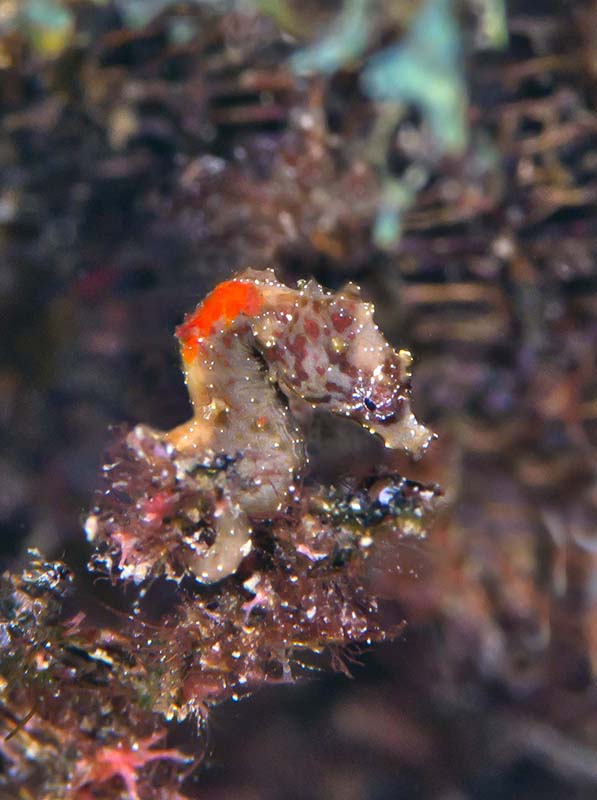
In the world of underwater macro photography, few subjects are so perfectly suited for spectacular one-to-one macro image capture than the venerable pygmy seahorse. These are tiny animals. The largest species measure a mere 3/4” with the smallest measuring an astounding 1/4” as full-sized adults. There are seven different species of pygmy seahorses currently described in the genera Hippocampus, and all are found in the Indo-Pacific. Pygmy seahorses are such an iconic subject to underwater photographers, there is hardly a dive destination within their distribution range without at least one special dive site featuring these diminutive creatures.
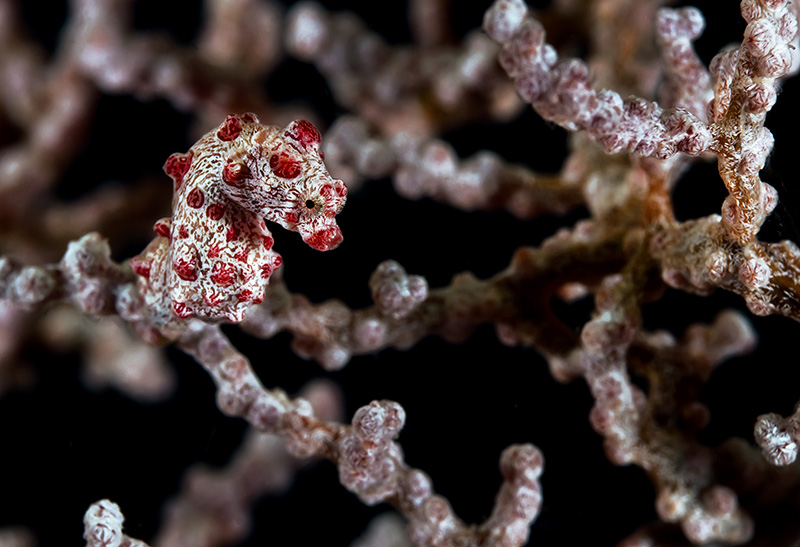
Pygmy Seahorse Biology
According to marine biologist Dr. Richard Smith, the leading expert on pygmy seahorse biology, pygmy seahorses are morphologically distinct from all other seahorses. What separates a pygmy from other seahorses, (in addition to their tiny stature) is the single gill opening on the back of the head (verses a pair of gill openings on either side of the head) and the young are brooded within the male’s trunk rather than a pouch on the tail.
Of the seven species, the two that are widely distributed and most commonly encountered by divers over their broad range are: Hippocampus bargibanti and Hippocampus denise (commonly known as Bargibanti’s and Denise’s pygmy seahorse respectively). These two species have evolved a special association with sessile coral reef invertebrates and are only found living on gorgonian corals. While Denise’s pygmy seahorse is known to live on at least nine genera of gorgonians, Bargibanti’s pygmy seahorse is found on a single genus of gorgonian coral, Muricella.
Being host specific, Denise’s and Bargibanti’s pygmy seahorse are perfectly suited for invisibly thriving on their colorful hosts by mimicking both color and physical texture of the gorgonia. Once Denise’s and Bargibanti’s pygmy seahorse settle on a specific host after floating a few days among the plankton subsequent to birth, they remain on that very gorgonia for the rest of their lives.
It’s this specificity of host which makes it easy for resorts and liveaboards to bring their divers to the exact location where these tiny fish are found on a regular basis.

The Double Edged Sword
But the same pygmy seahorse biology which makes them accessible photography subjects, also makes them vulnerable: on the one hand, the near guaranteed availability of such a premier macro subject ensures shooters get a chance to photograph a critter on their bucket list. On the other, the number of divers visiting the diminutive animals day after day at these locations could result in negative impacts on not only the animals themselves, but also on their specialized habitat.
At one resort I visited recently with a popular gorgonia harboring a pair of Denise’s pygmy seahorses at a relatively shallow 45 feet (typically, Denise’s and Bargibanti’s pygmy seahorses and their host gorgonia are found twice as deep), I thought about the math: six divers in my group, each shooting an average of five images (based on our dive guide metering individuals to allow everyone to get their images) results in 35 flash-shots on the animals during our group’s dive. Multiply this times the number of other divers from other boats visiting the site throughout the day, and the number of “flash pops” to these little creatures becomes large: 5 more boats (with 6 divers each x 35 flash-shots per boat) equals 175 flash-shots (likely more) in a single day!
It’s not hard to envision the potential impact such attention could have on the behavior of these animals, especially when you consider the added risk of possible (likely) physical impact to the seahorse’s gorgonian home by a regular parade of divers.
Thankfully, all of the resorts and liveaboards I’ve dived over the years have been keenly aware of potential impacts from their divers and have implemented protocols aimed at best preserving the animals and their homes while also providing opportunities for their photographers. The following list of protocols are what I consider to be the collective best practices garnered from dive briefings from the resorts and liveaboards I’ve visited.
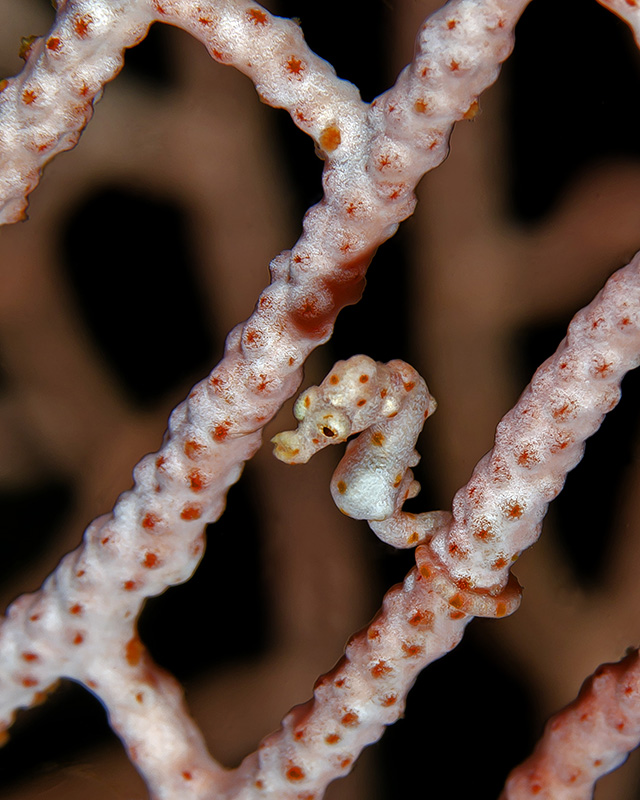
Shooting Protocol
1. Maintaining Situational Awareness: Like the fighter pilot constantly assessing airspeed, altitude and bogie threats in his or her immediate “airspace,” divers too must be constantly aware of their immediate “waterspace.” Am I neutral buoyant? Am I watching my fin wake close to the bottom? Am I managing my direction in the current?
All of these considerations and more have a direct impact when shooting pygmy seahorses. Stirring up the bottom or kicking sessile animals on a reef wall with your fins due to bouyancy and/or current issues can wreck havoc on the local environment not only endangering the animals but also ruining image capture opportunities for other divers.
2. No Touch Rule: I’m fairly certain that you would not want to be poked by a finger from the jolly green giant. So too it goes for the tiny pygmy seahorse. We should never physically touch the seahorse and should avoid to the maximum extent touching the host gorgonia.
The dive guides, as mentioned above, are vested in protecting these animals and their homes. They dive with these creatures almost daily and have a much better gauge on what can be done to allow divers to get their image without imparting harm. Accordingly, allow the dive guide to assist you in getting your shot.
3. Be Courteous of Other Shooters: Unless you are exceedingly lucky to find a pygmy seahorse on your own, chances are that you will be with a group of divers all wanting to get their shot. It’s therefore important that you are cognizant of sharing the opportunity. Often, pygmy seahorses are found relatively deep. Both the Bargibanti and Denise live generally below 60 feet and often more like 90 feet where bottom time is at a premium. Don’t be a subject hog; make sure you share the opportunity with your fellow photographers. If getting the “perfect shot” is most important to you, go last!
4. Be Judicious with Your Shooting: Remember, at popular destinations with lots of divers, these animals are possibly getting flash-popped hundreds of times in a day! So be judicious in your image capture. This said, there is an obvious balance between being judicious and being selfish. The last resort I dived, a photographer in my group wanted the “award winning shot” of a particular macro subject. She was definitely judicious, taking only five shots…but over the course of 20 minutes essentially blocking everyone else from shooting the subject!
5. Have Your Dive Guide Assist: Getting assistance from your guide can be arranged before the dive and will enable the best opportunity for good image capture for pygmy seahorses.
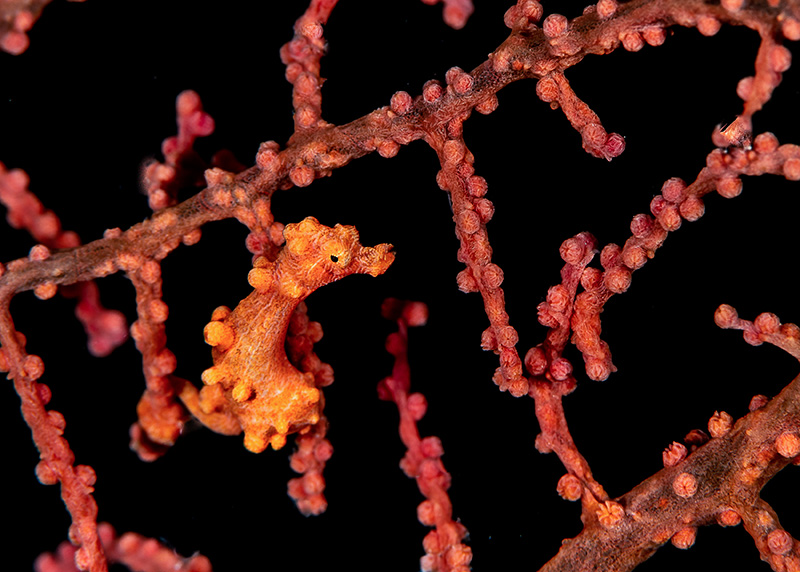
Equipment
Since pygmy seahorses measure between 1/4 and 3/4 of an inch in length, they are perfect for one-to-one macro photography. Therefore, any system, be it a compact camera with a wet lens diopter or a full blown, 35mm pro-level SLR/mirrorless camera with interchangeable lenses, which can achieve one-to-one image capture, will work. Ironically, when it comes to shooting pygmy seahorses, I believe the shooting advantage goes to compact camera system shooters for several reasons.
First, compact systems are smaller and, therefore, more maneuverable underwater. Second, since focus and framing are done via the LCD on the back of the camera, through the housing, it’s much easier to find the subject (vs. looking though an SLR viewfinder). Third, since shooters are generally at “arms length” from the subject, their peripheral vision helps them maintain better situational awareness within the waterspace. Finally, since compact cameras use smaller sensors, the physics associated with shorter focal length lenses or lens/diopter combinations to achieve one-to-one image capture, results in a deeper depth of focus at the smallest f-numbers, than their 35mm sensor equivalents. This often enables sharp focus through the depth of the entire animal.
Regardless of the type of camera system you choose to use, flash fill via a strobe is a must. While dual strobes can be useful to add even light on both sides of the subject, a single strobe placed above the centerline of the lens will present excellent results. Going with a single strobe also aids the shooter in maneuvering the camera to capture images potentially minimizing physical impact to the pygmy seahorses’ host home.
Snoots have become widely popular but can be difficult to use when shooting pygmy seahorses because the light source must be so close to the subject for proper illumination. This increases the likelihood of physical contact with the host gorgonia if not the seahorse. While we’d all like to capture a stunning shot without assistance, having the dive guide assist you by holding the snoot in position for your shot is a great option for a low impact, high probability image capture.
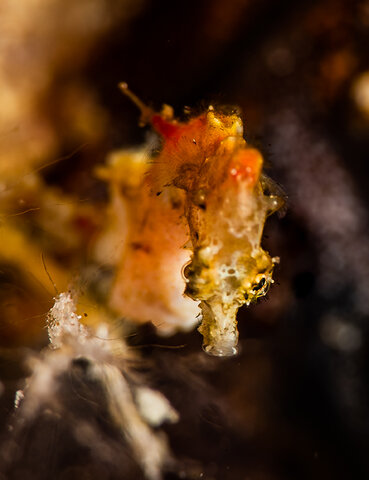
Technique
Pygmy seahorses are exceedingly shy animals which do not like to make eye contact. They do their best to turn away from photographers looking for the perfect head-on portrait shot. While not impossible, it can be achieved tempering the courtesy and situational awareness protocols discussed earlier coupled with a little luck. This said, side portrait shots are easier to achieve and can be particularly stunning if the animal is isolated from the host with negative space behind its perch.
Spot focus is recommended, if available on your camera system, with the focal point always placed on the eye of the seahorse. This will ensure that the main point of interest in your image, the eye(s), will be sharp. Images can tolerate softness on either side of the animal provided that the eye is tack sharp.
Pygmy seahorses lend themselves well to the vertical shooting format based on their shape. If you are looking to shoot a vertical image, attempt to do this in the camera rather than in post process cropping as you will have more file information to work with in post processing. This can be critical if you need to enlarge the image in post processing for better composition.
During shooting, don’t forget to check your images in your LCD and histogram for proper exposure, clipping and focus before you leave your subject (keeping in mind the shooting protocol). It’s a bummer thinking you’ve nailed your shot only to find that the image is sorely lacking during post processing because you failed to validate critical focus and exposure.
Most of us are on travel lock down right now during these uncertain times. But I look forward to the future when I can again book a destination trip to a beautiful reef to carefully and respectfully shoot these amazing creatures.
